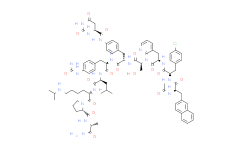| Cas No.: | 214766-78-6 |
| Chemical Name: | Degarelix acetate |
| Synonyms: | Degarelix acetate;N-Acetyl-3-(2-naphthyl)-D-alanyl-4-chloro-D-phenylalanyl-3-(3-pyridyl)-D-alanyl-L-seryl-4-[2,6-dioxohexahydropyrimidin-4(S)-ylcarboxamido]-L-phenylalanyl-4-ureido-D-phenylalanyl-L-leucyl-N6-isopropyl-L-lysyl-L-prolyl-D-alaninamide acetate;Degarelix;Ac-D-2Nal-D-4Cpa-D-3Pal-Ser-4Aph(L-hydroorotyl)-D-4Aph(carbamoyl)-Leu-ILys-Pro-D-Ala-NH2;acetyl-3-(naphthalen-2-yl)-D-alanyl-4-chloro-D-phenylalanyl-3-(pyridin-3-yl)-D-alanyl-Ser-4-((((4S)-2,6-dioxohexahydropyrimidin-4-yl)carbonyl)amino)-L-phenylalanyl-4-(carbamoylamino)-D-phenylalanyl-Leu-N6-(1-methylethyl)-L-lysyl-Pro-D-Ala-NH2;SX0XJI3A11;UNII-SX0XJI3A11;地加瑞克 |
| SMILES: | CC(C)NCCCC[C@H](NC(=O)[C@H](CC(C)C)NC(=O)[C@@H](CC1=CC=C(NC(N)=O)C=C1)NC(=O)[C@H](CC2=CC=C(C=C2)NC(=O)[C@@H]3NC(=O)NC(=O)C3)NC(=O)[C@H](CO)NC(=O)[C@@H](CC4C=NC=CC=4)NC(=O)[C@@H](CC5=CC=C(Cl)C=C5)NC(=O)[C@H](NC(C)=O)CC6C=C7C(C=CC=C7)=CC=6)C(=O)N8[C@H](CCC8 |
| Formula: | C82H103ClN18O16.C2H4O2 |
| M.Wt: | 1692.33 |
| Sotrage: | 2 years -20°C Powder, 2 weeks 4°C in DMSO, 6 months -80°C in DMSO |
| Description: | Degarelix is a competitive and reversible gonadotropin-releasing hormone receptor (GnRHR) antagonist. |
| In Vivo: | At single subcutaneous injections of 0.3 to 10 μg/kg in rats, degarelix produces a dose-dependent suppression of the pituitary-gonadal axis as revealed by the decrease in plasma luteinizing hormone (LH) and testosterone levels. Duration of LH suppression increases with the dose: in the rat, significant suppression of LH lasted 1, 2, and 7 days after a single subcutaneous injection of degarelix at 12.5, 50, or 200 μg/kg, respectively[3]. Degarelix is stable when incubated in microsomes and cryopreserved hepatocytes from animal liver tissue. In rat and dog, most of the degarelix dose is eliminated within 48 h via urine and feces in equal amounts (40–50% in each matrix), whereas in monkey the major route of excretion is fecal (50%) and renal (22%)[4]. |
| In Vitro: | Degarelix acts directly on the pituitary receptors for luteinizing hormone-releasing hormone (LHRH), blocking the action of endogenous LHRH. The use of degarelix eliminates the initial undesirable surge in gonadotropin and testosterone levels, which is produced by agonists of LHRH[1]. Degarelix treatment reduces cell viability in all prostate cell lines (WPE1-NA22, WPMY-1, BPH-1 cells, VCaP cells), with the exception of the PC-3 cells. The GnRH antagonist degarelix exerts a direct effect on prostate cell growth through apoptosis[2]. |

 DC Chemicals' products qualify for U.S. tariff exemptions. We guarantee no price increases due to customs duties and maintain stable supply, continuing to deliver reliable research solutions to our American clients.
DC Chemicals' products qualify for U.S. tariff exemptions. We guarantee no price increases due to customs duties and maintain stable supply, continuing to deliver reliable research solutions to our American clients.





















